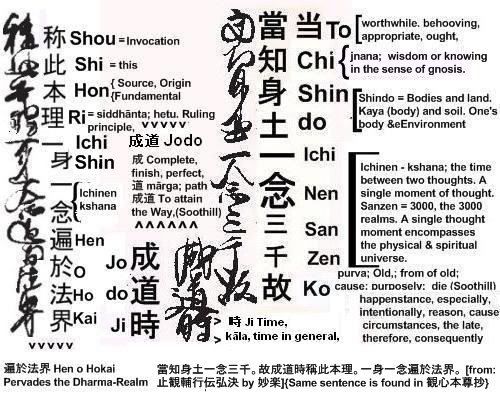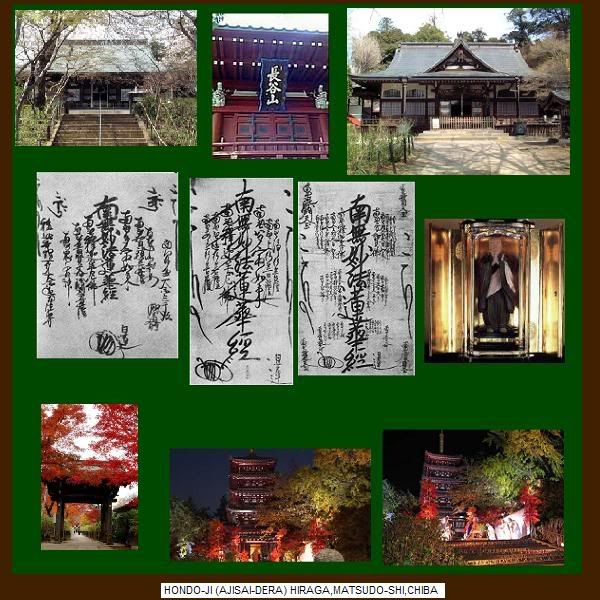
- [Mandala] Number {番号}: 008
- Era & Year {年}: Bun'ei Era {文永} Year Unknown.
- Month; Moon {月}: Unknown
- Day; Sun {日}: Unknown
- Estimated Date: It is thought that the Ichinen Sanzen Honzon was written in June of 1272, at Ichi-no-sawa, which is modern Sawata, Sado. At the time, Nichiren was staying at the residence of Kondo Kiyohisa
- Nichiren's Laudatory Inscription {讃文}: None
- Conferral; Recipient {授与書}: None
- Kept at, Housed at, Possession {所蔵}: Chiba Prefecture {千葉県} Hiraga {平賀} Hondoji {本土寺}
- Nickname/Popular Name {通称}: Ichinen Sanzen {一念三千} Honzon {本尊}
- Sheets {紙数}: One {1} Paper {1紙}
- Height {丈}: 39.7 cm/15.62 inches inches
- Width {幅}: 30.3 cm/ 11.9 inches
- Side Note or Scriptural Quotation: 當知身土一念三千。故成道時稱此本理。一身一念遍於法界。 [from: 止観輔行伝弘決 by 妙楽]{Same sentence is found in 観心本尊抄}
As of April of 1272, Nichiren, then in exile on Sado Island, had been transferred from Tsukahara (eastern central Sado), to the residence of Kondo Kiyohisa at Ichinosawa (modern Sawata, west central Sado, near Mano Bay).
The Esoteric Ichinen Sanzen Honzon or Amulet is one of about 8 early honzon that are not dated. It is thouht that it was written in June of 1272 at Ichino-no-sawa. There are 3 Nichiren Temples that I know of in the Sawata area. These are Abutsubo Myosenji, Sado Jisso-ji, and Sado Myoshoji. Sado Myoshoji was likely the site of the residence of Kondo Kiyohisa.
What makes the Ichinen Sanzen Mandara unique, is the inclusion of the siddham, or two esoteric sanskrit seed symbols, for the Buddha Mahavairochana (Dainichi). In Nichiren’s time, the eclectic-syncretic Jimon-Tendai and Shingon Schools, who ran the Buddhist temples at Kamakura Tsurugaoka Hachimaguji, viewed Shinto Kami as manifestations of Buddhist Divinities. The most important of these was the syntheses of the Sun Goddess Amaterasu Omikami or Tensho Daijin with Dainichi. This also relates to the Siddham symbols for Aizen and Fudo, which are on many of Nichiren’s Mandala Gohonzon.

Side Note or Scriptural Quotation: 當知身土一念三千。故成道時稱此本理。一身一念遍於法界。 [from: Annotations on "Great Concentration and Insight" 止観輔行伝弘決 {Shikan-bugyo-den-guketsu} by 妙楽 {Miao-lo, Myoraku, aka Chan-jan}] [The same sentence is also found in 観心本尊抄 {Kanjin Honzon Sho}]
"The Great Teacher Miao-lo says: 'You should understand that one’s life and its environment at a single moment encompass the three thousand realms. Therefore, when one attains the Buddha way, one puts oneself in accord with this fundamental principle, and one’s body and mind at a single moment pervade the entire realm of phenomena.'" -- Kanjin Honzon Sho, WND translation
"One should achieve the gnosis that one's body and land is the reality of Ichinen Sanzen. When one attains the way by the cause of invoking this original principle, one's body and ichinen pervade all of the Dharma Realm." -- my translation of the same phrase.
當知身土一念三千 {to chi shindo ichinen sanzen}。
- 當 {to} = It is germane to, one ought to, it is proper to, it behooves one.
- 知 {chi} = jnana, gnosis, subjective wisdom, what one correctly and implicitly knows.
- 身土 {shindo} = Body and Land. " Body, and environment. The body is the direct fruit of the previous life; the environment is the indirect fruit of the previous life." -- Soothill
- 一念三千 {ichinen sanzen} = One thought-moment 3000. 念 {nen} here is a translation of kshana, not sati / smrti {mindfulness} in this case. Kshana is said to be a measure of time equal to 1/75 of a second. It is taken to mean a thought moment, or the interval between two thoughts. "In one thought, to survey or embrace the 3,000 worlds, or a chiliocosmos with all its forms of existence; to see the universe as a thought; it is a Tiantai mode of meditation." -- Soothill
故成道時稱此本理 {ko jodo ji sho sho hon ri}。
- 故 {ko} = ?? Cause. ancient?
- 成道 {jodo} = Attain the way, complete the path.
- 時 {ji} = Time, hour, when.
- 稱 {sho} = To invoke, address, call.
- 此 {shi} = This
- 本 {hon] = main, true, real. It is used to mean much the same thing as Adhi or Adi; in the sense of the source, primary, original, primordial, and so on. "Radical, fundamental, original, principal, one's own; the Buddha himself, contrasted with 蹟 [shaku], traces [imprints] left by him among men to educate them; " -- Soothill
- 理 {ri} = Principle "siddhānta; hetu. Ruling principle, fundamental law, intrinsicality, universal basis, essential element; nidāna, reason; ..." -- Soothill
一身一念遍於法界 {ichi shin ichinen hen o hokai}。
- 一 {ichi} = one. sometimes indicates 'all of.'
- 身 {shin} = body,
- 一念 {ichinen} = eka kshana, one thought moment.
- 遍 {hen} = all pervasive, permeating all, universal, sarvatrag.
- 於 {o} = At, in, on, to, from, by, than.
- 法界{hokai} = Dharmadhatu . "(1) A name for "things" in general, noumenal or phenomenal; for the physical universe, or any portion or phase of it. ..." -- Soothill


Partial Tentative Transliteration:
IF YOU CAN CORRECT ERRORS; OR ADD SOMETHING; PLEASE DO!
On your left, facing, reading right to left: Namu Shakamuni Butsu - Namu Monju-Fugen Bosastsu - Namu Kishimojin
Down the center: Na Mu Myo Ho Ren Ge Kyo
On your right, facing, reading from left to right: Namu Taho Nyorai - Namu Chigi Bosatsu - Namu Jurasetsunyo
Sanskrit Seed Symbols: On the top, each side: Mahavairochana (Dainchi) On the right your left, facing: Aizen On your right, facing: Fudo
Bottom: Nichiren's Signature and Seal.
Images of the Ichinen Sanzen Mandala may be viewed by clicking on these links.
@ Nichiren's Coffeehouse Gohonzon Shu
@ lbis japanese gohonzon shu
@ GohonzonForum (Membership Required) / home page
@ GohonzonInfo (Membership Required) / home page
See Also: Lucia DOLCE Nichiren’s Attitude toward Esoteric Buddhism .PDF
The Ichinen Sanzen Honzon is now kept at the Hiraga Hondo-ji (Ajisaidera) Temple {Home Page} in Matsudo, of the old Shimousa Province on Boso Hanto. I believe this temple is affiliated with the Kamakura based Nichiro-Hikigayatsu lineage headquartered at Kamakura Myohonji .


Thanks for this post!
ReplyDeleteI'm an Indy practioner and this is the gohonzon I chant to.
Printed it out myself and frames it in my butsudan.
Ever since I first saw it over in gohonzon shu I felt a deep spiritual connection with it. Very profound sense of attachment.
Hopefully I can visit the temple it's enshrined in one day.
Who knows maybe in a past life I was a monk or priest there? LOL or a layperson living nearby who was devoted to it?
Anyway, awesome site! Thanks a ton for the info-
NMRK